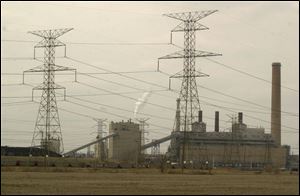
Decade's drought in constructing coal-fired power plants may end soon
4/2/2002
FirstEnergy recently agreed to sell its Bay Shore coal-fired plant in suburban Toledo to a Minneapolis firm.
After more than a decade without construction of a new coal-fired electricity plant in Ohio, a proposed project has moved a step closer to reality.
The Ohio Environmental Protection Agency late last week approved a plan by Global Energy, Inc., of Cincinnati, for a $550 million plant near Lima to burn a mixture of coal and municipal waste. The project, proposed in 1999, still needs approval from a Public Utilities Commission of Ohio before construction can begin.
A second project was proposed in December for an abandoned industrial site near Ashtabula, in northeast Ohio. Its builder would be Nordic Energy, of Ann Arbor.
Both projects would use a new clean-burning technology touted as dramatically reducing emission of pollutants.
Although expensive to build, coal-burning plants, which can be run 24 hours a day all year long, are the workhorses of power production in the Midwest, where coal is plentiful.
The last coal-fired plant to open in the state was William Zimmer near Cincinnati in 1991. It cost $3.4 billion - a price that was inflated because it was designed as a nuclear power station. Its coal-fired generating boiler alone cost $1.5 billion, according to its owners, Cinergy Corp.
Over the last decade independent power companies and Ohio's local utilities have confined themselves largely to building natural-gas-fired plants, which, although less costly to construct usually operate only during times of peak demand because of the high cost of their fuel.
The two new projects are intriguing, said Chad Munitz, assistant deputy director with the Ohio Department of Development's economic development division. In Ohio's newly deregulated electricity market, they could add to the state's available power supply and could increase the market for Ohio-produced coal, he said.
“I think that what you're going to see is a lot of investors going out and doing the hard work and figuring what the cost is going to be over a 10-to-30 year cycle for one of these [coal] plants,'' Mr. Munitz said.
Ralph DiNicola, a spokesman for FirstEnergy Corp., parent of Toledo Edison, agreed that the two projects are a positive sign, but cautioned, ``we have heard a lot of generation-side [projects] that have been announced that never go anywhere.''
FirstEnergy, which owns coal-fired plants and recently agreed to sell its Bay Shore power plant in suburban Toledo and three other coal-fired plants along Lake Erie to NRG Energy, Inc., of Minneapolis, might build more coal plants in the near future if it found the cost to be reasonable, Mr. DiNicola added.
“It's going to depend on the government's environmental position on emissions, tax credits, and other things,'' he said.